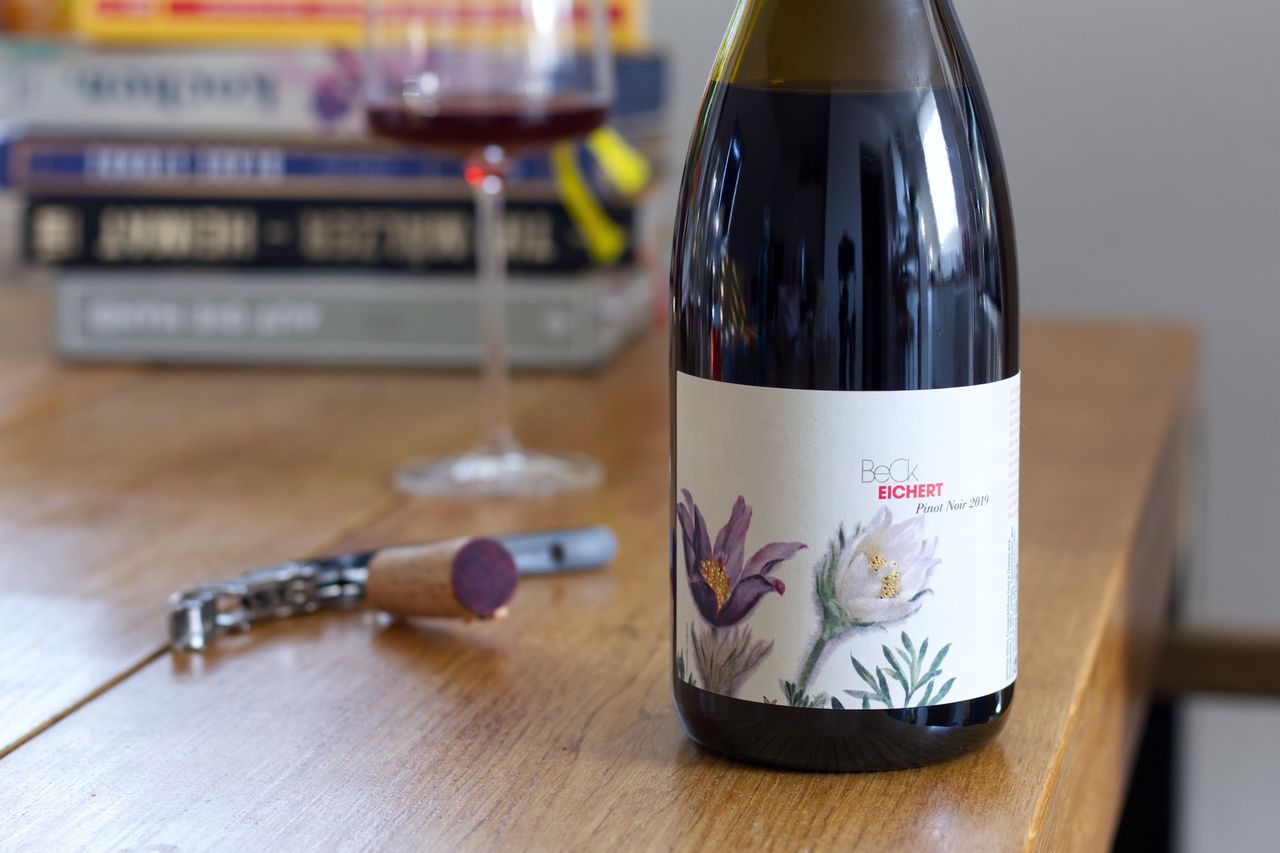Beck - Eichert 2019
We are drinking a bottle of Spätburgunder from Baden: Eichert 2019 by Charlotte and David Beck.

As pleasant as all the tasting on the road may be, somehow it always comes with a bit of stress. For me personally, because of the crowds everywhere, and for my sense of taste, which gets pretty tired after what is probably a three-digit number of sample sips. There’s nothing better than a single bottle at the home dining table. And if the bottle looks like today’s, then there’s something for the eye as well. I had never even heard of Charlotte and David Beck from the Kaiserstuhl. However, they must have nestled somewhere in my subconscious, probably because I saw the wine somewhere at some trustworthy place. Because without some subconscious recognition, we would probably pick a cheaper bottle to fill up an online shipment. Otherwise, the two usually fly under my radar, even though, just to spite me, this particular wine of course popped up in my Instagram feed a few days ago. Sometimes the universe just wants to mess with me.
Their rare appearance likely also has to do with the manageable number of bottles produced at Weingut Beck. Charlotte and David first crossed paths in Geisenheim. In 2013, they returned to David’s parents’ farm at the Kaiserstuhl, leased their first plot in Eichert, converted to organic cultivation, added a few more plots, more conversion, and then their first own vintage. Conversion takes time, 2017 saw the first wine, practically just yesterday. It’s now just under 2 hectares that they farm as a side business. All manual labor, minimalism. The vines grow at the Kaiserstuhl on volcanic soils in the heat of southern Baden. The grapes are spontaneously fermented in whole, then pressed in an old basket press before the juice disappears into small wooden barrels for just under 2 years. Sulphur is used as little as possible, and there’s no filtration or fining anyway.
The cork gives me a brief scare. That feeling when the corkscrew doesn’t grip properly because some crack or void is hidden in the bark, not a sensation I’d recommend. That gets the pulse up, at least until you stick your nose in the glass. Oh, this is lovely. And, to jump ahead, this won’t be the only time I write that about this wine. There’s dark fruit between cherry and blue or black berries, plenty of spice, and a touch of forest floor. The wine is dense, intense, with some sandalwood, some graphite. There’s an inner warmth in the wine, an inner calm. The following acid kick wakes me up. It’s fresh, juicy, and even on the palate, intense, like thick cherry juice that flows very slowly over the tongue to the back, tugging at the edges, tugging at the rear palate, but again, that inner peace. The tannin is velvety soft, lingers forever, and with the wine on your tongue, you smell even more fruit and a hint of animal stable. I don’t even want to write whether this tastes particularly German or, careful now, Burgundian. Doesn’t matter. What it does have is this effortlessness that I so appreciate in Burgundies. The feeling it gives, the confidence that the wine seems to exude. The spice in the mouth, the fruit, the freshness, the depth and intensity. Impressive. And just simply beautiful.
The fruit changes overnight. We pour the Pinot quite cold, a tribute to the summer heat, which, of course, is still relentlessly hammering through the skylight. Everything warms up on its own anyway, usually faster than you’d like, even when pouring generous amounts and drinking fast. But the chill does no harm, quite the contrary, somewhere between fridge-cold and room temperature, it brings out even more freshness from the wine. And, at least on such a warm evening, makes it even tastier. At the same time, it robs the wine of some depth. But, as already mentioned, it will warm up by itself, and with the temperature come leathery, spicy, woody, and smoky notes that bring back the depth and make the wine just a bit better. Sandalwood and eucalyptus, herb butter on freshly grilled steak, more than holding its own against the fruit on the nose. This is a Pinot for which mouth-blown goldfish bowl-sized glasses were mouth-blown (ours weren’t, Swabian thriftiness and all, but machine-blown glasses are now quite thin-walled too and a goldfish could still take big laps). There is power in the glass, which needs space, 2019 was warm, even hot. But with its 12.5% alcohol and acidity, the Eichert barely lets that show. The wine probably has many, many years ahead of it, but how could I recommend anything but opening it now? Maybe buy more. But definitely open one. It’s so clear, so radiant, so juicy and deep, and, yes, just beautiful. For me, and quite unexpectedly, one of the greatest wines of the year.